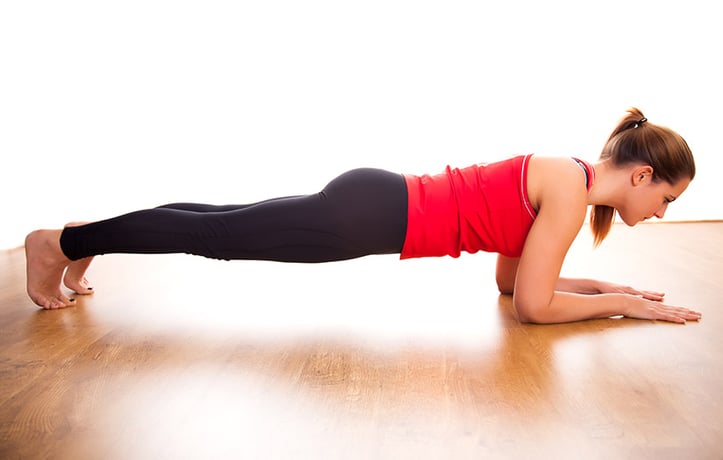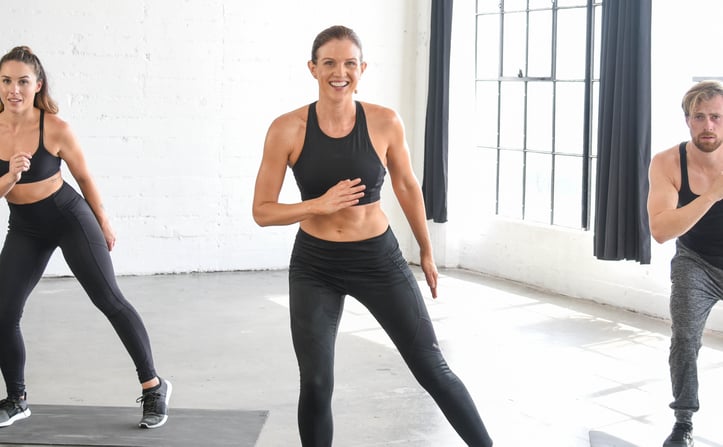
Master the Plank: A Step-by-Step Guide to Core Strength, Plus 4 Challenging Variations
The plank is a powerhouse exercise, renowned for its simplicity yet profound effectiveness in building a rock-solid core, strengthening shoulders, and supporting a healthy back. It's a foundational movement that improves stability, balance, and overall functional strength, making it a valuable addition to any fitness routine. In this guide, we'll break down how to perform a perfect basic plank, highlight common mistakes to avoid, and introduce four engaging variations to keep you challenged and progressing.
The Foundation: Nailing the Basic Plank Position
Mastering the basic plank is crucial before moving on to variations. Here’s how to do it correctly:
- Starting Position: Begin as if you're about to do a push-up. Place your hands directly under your shoulders, shoulder-width apart. Your feet should be hip-width apart, with your toes tucked under.
- Transition to Forearms (Forearm Plank - Most Common): Carefully lower one forearm to the ground, followed by the other. Your elbows should be directly beneath your shoulders, and your forearms parallel to each other (or you can clasp your hands if that's more comfortable, though parallel forearms often engage more stabilizer muscles).
- Engage Your Core: This is paramount. Actively pull your belly button in towards your spine, as if you're bracing for a gentle punch to the stomach. You should feel your abdominal muscles tighten.
- Create a Straight Line: Your body should form a straight, rigid line from the crown of your head, through your shoulders and hips, down to your heels. Avoid letting your hips sag towards the floor or pike upwards towards the ceiling.
- Shoulder Blade Position: Gently draw your shoulder blades down and back, away from your ears. Avoid letting them wing out.
- Head and Neck: Keep your neck in a neutral position, aligned with your spine. Your gaze should be down towards the floor, slightly ahead of your hands.
- Hold and Breathe: Maintain this position for your desired duration (e.g., starting with 20-30 seconds and gradually increasing). Remember to breathe steadily and deeply throughout the hold.
(Alternative: High Plank - If performing a plank on your hands instead of forearms, ensure your hands are directly under your shoulders, and your arms are straight but not locked at the elbows.)
Common Plank Pitfalls: Avoid These Form Mistakes
Proper form is essential to maximize benefits and prevent injury. Watch out for these common errors:
- Sagging or Arching the Back (The "Banana Back"): This is perhaps the most common mistake. It disengages your core and puts undue stress on your lower back.
- Correction: Re-engage your core by pulling your navel to your spine. Squeeze your glutes (buttock muscles) slightly to help stabilize your hips and maintain that straight line.
- Holding Your Breath: This can increase blood pressure and make the exercise feel much harder.
- Correction: Focus on maintaining steady, controlled breathing – inhale through your nose, exhale through your mouth.
- Hips Dropping or Piking Too High: Letting your hips drop shifts stress to your lower back. Piking them too high reduces core engagement.
- Correction: Actively think about keeping your hips in line with your shoulders and ankles. A quick glance in a mirror (if available) or asking someone to check your form can be helpful initially.
- Not Fully Engaging the Core: Simply holding the position without actively contracting your abdominal muscles will limit the exercise's effectiveness.
- Correction: Continuously focus on that "belly button to spine" cue. Imagine you're trying to prevent your stomach from touching the floor.
- Shoulders Hunching or Head Dropping:
- Correction: Keep your shoulders broad and away from your ears. Maintain a neutral neck alignment.
Level Up: Four Plank Variations to Challenge Your Core
Once you can comfortably hold a basic plank with good form for a minute or more, introduce these variations to add intensity and target different muscle groups:
-
Side Plank:
- How-to: Lie on your right side. Place your right elbow directly under your right shoulder, forearm flat on the ground perpendicular to your body. Stack your left leg directly on top of your right, feet together. Engage your core and lift your hips off the ground until your body forms a straight line from your head to your feet. Your weight should be supported by your right forearm and the side of your right foot. You can extend your left arm towards the ceiling or rest it on your hip.
- Focus: Primarily targets the obliques (side abdominal muscles), shoulders, and improves lateral stability.
- Hold: Aim for 20-30 seconds per side, gradually increasing.
-
Forearm Plank with Hip Dips:
- How-to: Start in a standard forearm plank position. Keeping your core tight, slowly rotate your hips and dip your right hip towards the floor (without letting it touch). Return to the center, then dip your left hip towards the floor. Continue alternating sides in a controlled manner.
- Focus: Intensifies oblique engagement and challenges core stability through dynamic movement.
- Reps: Aim for 8-12 dips per side.
-
Plank with Shoulder Taps (High Plank Variation):
- How-to: Begin in a high plank position (on your hands, not forearms), with hands directly under shoulders and feet slightly wider than hip-width for better stability. Keeping your core engaged and hips as still as possible (minimize rocking), lift your right hand off the ground and gently tap your left shoulder. Return your right hand to the ground, then lift your left hand and tap your right shoulder.
- Focus: Challenges core stability, anti-rotational strength, and shoulder stability.
- Reps: Aim for 8-10 taps per shoulder.
-
Plank with Alternating Leg Raises:
- How-to: Start in a standard forearm or high plank position. Keeping your core braced and back flat, slowly lift your right leg straight up off the ground, only a few inches (hip height is plenty – avoid arching your lower back). Hold for a second or two, then slowly lower it back down. Repeat with your left leg.
- Focus: Targets the lower abdominals, glutes, and lower back extensors, while challenging overall stability.
- Reps: Aim for 8-10 raises per leg.
The Multifaceted Benefits of Planking
Beyond a sculpted core, incorporating planks into your routine offers a wealth of benefits:
- Improved Posture: Planks strengthen the muscles around your spine, shoulders, and chest, which are crucial for maintaining good upright posture and can help alleviate back pain.
- Enhanced Balance and Stability: The isometric hold required for a plank significantly improves your body's ability to stabilize itself, translating to better balance in daily activities and sports.
- Increased Metabolic Rate: As a compound exercise engaging multiple muscle groups, regular planking can contribute to a higher resting metabolic rate over time.
- Reduced Risk of Back and Spine Injury: By strengthening your core, you provide better support for your spine, reducing the risk of back injuries during other exercises or everyday movements.
- Improved Flexibility (Posterior Chain): While primarily a strength exercise, plank variations can also help stretch and lengthen the muscles along the back of your body (posterior chain), like the hamstrings and arches of your feet.
Tips for Planking Success: Maximize Your Efforts
To get the most out of your planking workouts, keep these tips in mind:
- Start Slow & Progress Gradually: If you're new, aim for shorter holds (15-20 seconds) with perfect form. It's better to do multiple short, correct planks than one long, sloppy one. Gradually increase your hold time or reps as you get stronger.
- Form Over Duration, Always: Prioritize maintaining a straight line and engaged core. If your form starts to break, end the set, rest, and try again.
- Vary Your Routine: Don't just stick to one type of plank. Incorporate the variations to challenge different aspects of your core and prevent plateaus.
- Consistency is Key: Aim to include planks in your workouts 2-4 times per week. Regularity will yield the best results.
- Breathe! It's easy to hold your breath during an intense exercise, but consistent breathing delivers oxygen to your working muscles.
Your Plank Challenge Awaits!
The plank, in its many forms, is a remarkably versatile and effective exercise for building a strong, resilient core and enhancing overall fitness. By focusing on proper technique, progressively challenging yourself with variations, and staying consistent, you'll undoubtedly see and feel the powerful benefits.
So, what are you waiting for? Roll out your mat, find your focus, and start planking your way to a stronger, more stable you today!

Fit vs Fat: Decoding Health's True Ruler

Pump Up Your Heart: Science-Driven Weight Loss

Wellness Technology: Your Path to Sustainable Weight Loss

A Sensible Guide to Dietary New Year's Resolutions

Prevent Shoulder and Rotator Cuff Injuries with Corrective Exercises

Overcome Fitness Plateaus: 4 Tips for Success

10 x 10 Thanksgiving Day Circuit: A Fitness Guide

Unleash Your Fitness Potential with Kit Rich's Training Secrets

The Future of Fitness: A Guide for Beginners to Intermediates

